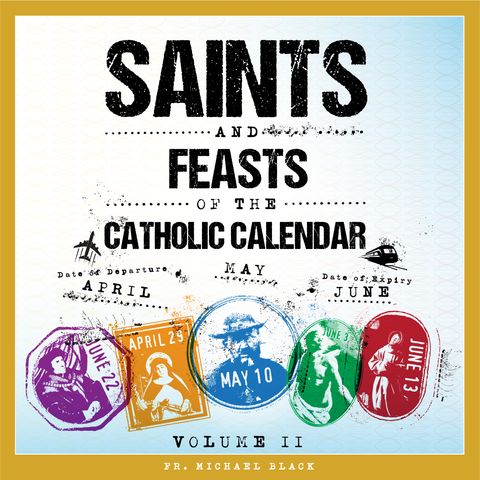May 18: Saint John I, Pope and Martyr

Sign up for free
Listen to this episode and many more. Enjoy the best podcasts on Spreaker!
Download and listen anywhere
Download your favorite episodes and enjoy them, wherever you are! Sign up or log in now to access offline listening.
Description
May 18: Saint John I, Pope and Martyr c. Late Fifth Century–526 Optional Memorial; Liturgical Color: Red The pope is crushed in a secular vice by two worldly masters The...
show morec. Late Fifth Century–526
Optional Memorial; Liturgical Color: Red
The pope is crushed in a secular vice by two worldly masters
The early Popes were Roman citizens who retained their birth or baptismal names upon being elected to the See of Peter. Their names perfectly reflect a flourishing Roman culture rather than the Christian subculture which was gradually budding and flowering in its midst. So there are Popes Clement, Linus, Anacletus, Sixtus, Victor, Callixtus, Urban, and Fabian. It sounds like a roll call of Roman senators in white togas seated on the marble benches of the Forum. It is not until 254 that Pope Stephen bears a name from the New Testament and not until 336 does Pope Mark honor an Evangelist.
Considering the centrality of Saints John the Evangelist and John the Baptist to the Christian story, it is surprising that five hundred years transpired before today’s saint, Pope John I, so honored their memory. A pope is only called the “First” once there’s a “Second.” In 533 a man named Mercurius succeeded today’s John as Bishop of Rome. Mercurius’ birth name was so overtly pagan—honoring the Roman God Mercury—that he chose to honor his martyred predecessor John by adopting his same name. Mercurius thus initiated the venerable tradition of a pope adopting a new name upon his election. At the same time he also retroactively turned Pope John into Pope John I.
The flow of the early martyrs’ blood had long since ceased by John I’s election in 523. There was no emperor or court even left in Rome by 523 for barbarians to attack. The traditional date of the fall of the Western Roman Empire is 476. John I was, then, the pope of a declining, far western outpost of an empire whose central government had been in Constantinople for almost two hundred years by John I’s election. Rome was fading.
The Empire’s long, slow decline in Italy had created a vacuum. Rugged tribes of the North, including the Ostrogoths (Eastern Goths), poured south into the warm valleys and cultured towns of the Italian countryside and saturated Rome itself. The Ostrogoths had called the Italian peninsula home for so long that, by the sixth century, they were part Roman, part barbarian, and part Christian. Borderlands are always a mix. For complex historical reasons, the Ostrogoths and their Italian ruler, Theodoric, were Arians. Their prior isolation in Northern Europe had prohibited them from absorbing the teachings of the fourth-century Councils of Nicea and Constantinople. So the Ostrogoths were unaware that the Church had decisively rejected the Arian heresy, which held that Christ was a god, but not the God.
It was amidst these tense political and religious circumstances that poor Pope John I was placed in an impossible situation. John was caught between the Emperor Justin in remote Constantinople, who exercised significant control over Church discipline, and Theodoric, who was standing right at his side, breathing down his neck. Justin had issued an edict ordering the Arians, including the Ostrogoths in Italy, to surrender their churches to the Catholics. Theodoric would have none of it. He was as angry as a hornet. To him, it was the first step toward Constantinople reasserting its control over Italy, something the Ostrogoths would resist to the death. So Theodoric sent Pope John at the head of a large embassy of Roman dignitaries to Constantinople to demand that Justin withdraw the edict. Pope John obediently went. He was greeted in the capital with elaborate ceremony and honored as head of the Church. But he could not, and did not, secure what Theodoric so desired. It was impossible. The edict was binding.
When Pope John and his party crossed the Adriatic Sea to return to Rome, they landed at Ravenna. Theodoric, who had heard of Pope John’s failure to have the edict rescinded, imprisoned him. And there the Pope died, in Ravenna, perhaps of shock, perhaps of mistreatment. His blood did not run red like the martyrs of old, but he died a victim for Christ nonetheless, unable to simultaneously satisfy two powerful secular masters. John I’s mortal remains were returned to Rome. In keeping with the custom for all popes since Pope Leo the Great (440–461), Pope John I was interred in the nave of the Constantinian Basilica of St. Peter. When the new St. Peter’s was built in the sixteenth and seventeenth centuries, John’s tomb did not surface nor did any epitaph. But Pope Saint John I is still there, somewhere, under the floor of St. Peter’s, arms crossed, facing up, ring on his bony finger, vested in gold, miter crowning his head, as waves of tourists walk on the marble floor above him. He rests in peace, forgotten to but a few.
Pope Saint John I, your fidelity to your vocation as Pope led to your death. You were faithful in the face of threats from civil power but did not bend to its will. May all popes look to your example for inspiration in leading the Church.
Information
| Author | Fr. Michael Black |
| Organization | Michael Black |
| Website | - |
| Tags |
Copyright 2024 - Spreaker Inc. an iHeartMedia Company
